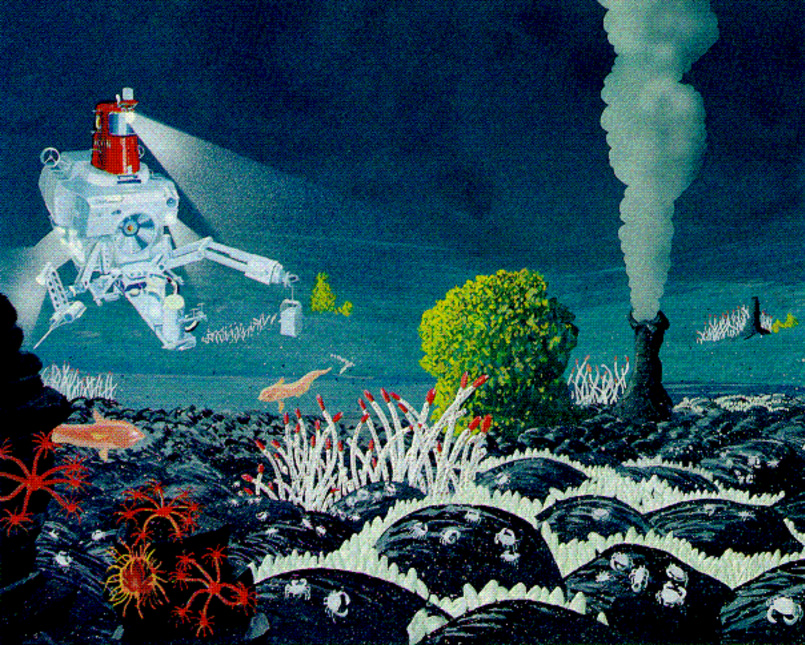
[ home port |
lectures |
labs |
surf |
Hydrothermal Vent Communities and
the Story of "Tubeworm Barbeque"

1977 - 1st
discovery of hydrothermal vents (8-12°C) and animals
at the Galapagos Rift
1979 - 1st black smoker vents (350°C)
discovered at 21°N on the intermediate-spreading East
Pacific Rise
1981 - vents discovered on the intermediate-
spreading Juan de Fuca Ridge off Oregon/Washington
1982 - vents discovered in the sedimented Guaymas
Basin, Gulf of California
1984 - 1st low temperature (methane) seep
community discovered on a subduction zone (Cascadia)
instead of a mid-ocean ridge
1985 - vents discovered on the slow-spreading
Mid-Atlantic Ridge; seeps discovered at Japan and Peru-Chile subduction
zones (trenches)
1987 - vents discovered on a spreading center
behind a subduction zone in Marianas Basin (near Guam)
1991 - Tubeworm Barbeque discovered within 2 weeks of an eruption, East Pacific Rise
1993 - discovery of shallowest known vent
community (1000 m depth) at Lucky Strike on slow-spreading
Mid-Atlantic Ridge
2006 - first underwater volcanic eruption actually witnessed in real-time
by anyone, NW Rota 1 volcano, Marianas
-
The findings of
unusually dense populations of animals in the deep sea,
clustered around hydrothermal vents, was originally a
puzzling discovery. As anywhere else on earth, animal life
in the deep sea was known to be sustained by plants; mainly
by phytoplankton of surface waters. These photosynthetic
primary producers of organic carbon from carbon dioxide
(CO2) form the base of the food chain. However,
only a small fraction of the total organic matter produced
escapes recycling in surface waters and further
decomposition in the water column by sinking relatively
quickly as particulate material to the bottom. So in
principle, the deeper the bottom, the fewer the food
particles arrive, and consequently, the smaller the benthic
animal biomass.
-
In light of this, the biomass of the vent
communities discovered on the seafloor was much too high.
Its quantity and distribution suggested a food source other
than organic particles trickling down from the surface. The
dense clusters of mussels, clams, and tubeworms around vent
openings indicated a highly localized food source. When
hydrogen sulfide was found to be a substantial
constituent of the fluids emitted from these vents, the
possibility of chemosynthetic primary production of organic
carbon became apparent. Today, after several years of work
at the vents and in the laboratory, this hypothesis is
accepted as fact.
- Whereas on the surface, photosynthesizing
bacteria are the base of the food chain, on the deep
seafloor it is chemosynthesizing bacteria:
CO2 + 4H2S + O2 = CH2O
+ 4S + 3H2O
carbon dioxide & hydrogen sulfide ---> organic
carbon & sulfur (chemo)
carbon dioxide & light ---> organic carbon &
oxygen (photo)
-
In April 1991, a team of scientists visiting the
fast-spreading East Pacific Rise (EPR) at 9°N was the
first to witness the near aftermath of a deepsea eruption, at the
time one of the Holy Grails of oceanography. An all-women crew (Rachel Haymon,
Karen Von Damm and pilot Cindy Lee Van Dover) aboard the
submersible Alvin (another first) witnessed fresh lava shards on the
seafloor dusted by fine gray ash, which they later learned was less
than 2 weeks old. Dead tubeworms were scattered about like spent firecrackers.
Since the specimens carried to the surface still had freshly charred flesh,
the site was dubbed by Haymon as the Tubeworm Barbecue. This site
remains part of a long-term scientific observatory to this day.
- This event wiped out
many of the existing vent communities in the region. On
return visits in ‘92, ‘93, and ‘94
scientists documented the phoenix-like rebirth of
hydrothermal vent communities.
-
Many areas near Tubeworm Barbecue were blanketed
by acres of thick, white mats of bacteria in 1991. A year
later, brachyuran crabs had arrived and eaten most of the
bacteria away. Giant tubeworms had recolonized the eruption
site and grown to a length of over 4 feet.
By 1993 most of the tubeworms in some areas were
dead or dying, starved by the shutdown of the vents. Only
jellyfish-like siphonophores, nicknamed "dandelions" were
alive. These animals, about the size if ping-pong balls,
shoot minute stinging tentacles into the current to capture
food.
Another eruption may occur this year and kill
these communities off again. Living in this dangerous and
unstable environment, all vent fauna are governed by the
dictum: live fast, die young.
Scientists studying the 9°N segment of the
EPR have discovered 300 new species of animals. Many
questions remain unanswered, such as exactly how do
tubeworms, which have no structures for swimming or
crawling, colonize the vents?? How do all of these vent
creatures survive in conditions that would resemble a
toxic waste site??
The research into the abyss continues. . . .
(as long as there is
funding of course!)
[ home port |
lectures |
labs |
surf |
http://dusk.geo.orst.edu/oceans/tubeworm_bbq.html
| Origin date: October 8, 1998
| Last main update: October 11, 2013


